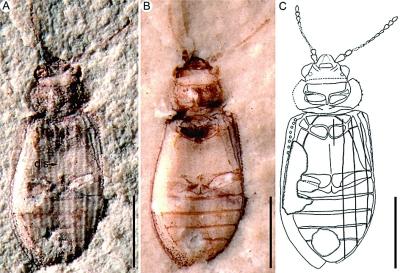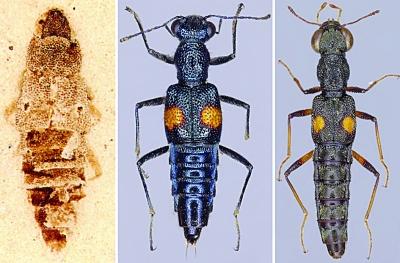


World's first fossil of a derodontidae is discovered from Inner Mongolia's Daohugou Bed, which dates to the middle-late Jurassic period. (Photo: Yangtze Evening News)

From left are the fossil of a new species of steninae from the Late Eocene France, a dianous, and a stenus.(Photo: Yangtze Evening News)
(ECNS) – Two Chinese and six foreign scientists have discovered the world's first fossil of a derodontidae, or tooth-necked fungus beetle, which dates back to 165 million years ago, the Yangtze Evening News reported.
Dr. Cai Chenyang and his mentor Huang Diying, from the Nanjing Institute of Geology and Paleontology, have cooperated with the six foreign experts on research of some 50,000 insect fossils from China and France for two years.
Among the fossils from Inner Mongolia's Daohugou Bed, which dates to the middle-late Jurassic period, the team found the body of a tooth-necked fungus beetle. It is only 3 mm in size.
Cai said the insect can be classified into the subfamily of Peltasticinae, a new genus very similar to Peltastica. Such insects are extinct in China, while the living species of the family only exists in South America.
The scientists also found a new species of steninae from the Late Eocene France, tracing back to 40 million to 50 million years ago.
Steninae has two genera, but the new species should be categorized into a third genus, said Cai. The little insect, which can fly, lives on the surface of water. "It can secrete a special chemical that allows it to walk on water," Cai explained.
And among fossils from Jehol Biota, another formation of 133 to 120 million years ago in Inner Mongolia, scientists found bodies of long-horned beetles, scarabs and lice.
The research results have been published in a recent European Journal of Entomology, the Australasian journal of paleontology Alcheringa, and peer-reviewed scientific journal Cretaceous Research.
Rare bird-like insect spotted in Hunan
2014-09-09World‘s largest aquatic insect found in Sichuan
2014-07-21Copyright ©1999-2018
Chinanews.com. All rights reserved.
Reproduction in whole or in part without permission is prohibited.